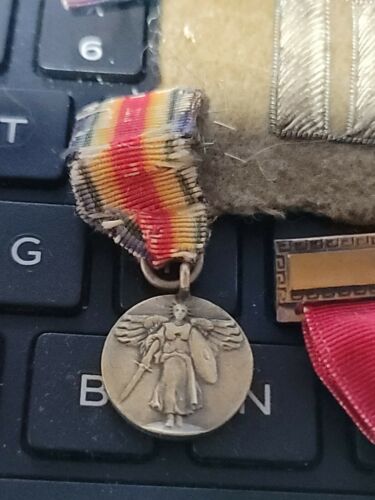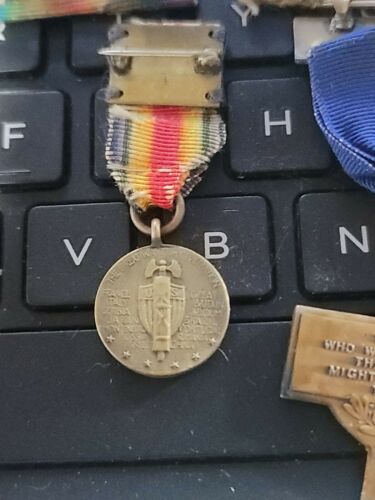-40%
WW1 US VICTORY MINI MEDAL +RIBBON OFFICER COLLAR DEVICE SIGNAL CORP -CAPT PATCH
$ 39.59
- Description
- Size Guide
Description
PLEASE FOLLOW OUR E BAY STORESEE ALL PICS
SALE
SEE OUR STORE
PLEASE READ WHOLE ADD
SEE STORE !!!!
Shooting World War I: The History of the Army Signal Corps Cameramen, 1917-1918
March 16, 2017
By
Audrey Amidon
, Posted In
Motion Pictures
,
Photographs
For the past two years, the National Archives Motion Picture Preservation Lab has been digitizing a series of Army Signal Corps films as part of a larger project to commemorate the centennial of World War I. Meanwhile, technicians from the Still Pictures Branch and the Digitization Division have scanned tens of thousands of Signal Corps photographs from World War I. Along the way, technician P.T. Corrigan, who performs quality control on the scanned images, forwarded photos of the cameramen to Lab staff, knowing that we love to see records of the people who shot the motion picture films we work with every day.
The following images are from a group of
22 photos documenting the Signal Corps School of Photography at Columbia University
in New York. These photos, along with the rest of the series
American Unofficial Collection of World War I Photographs, 1917-1918
, are available in our online catalog.
Provex motion picture camera instruction. (Local Identifier: 165-WW-103D-19, NAID: 26425767)
Explaining mechanical construction of Akeley camera. (Local Identifier: 165-WW-103D-4, NAID: 26425737)
In formation for practical camera instruction. (Local Identifier: 165-WW-103D-3, NAID: 26425735)
Different types of cameras for instruction purposes. (Local Identifier: 165-WW-103D-20, NAID: 26425769)
Different types of camera used in instruction course. (Local Identifier: 165-WW-103D-9, NAID: 26425747)
Akeley camera in operation. (Local Identifier: 165-WW-103D-17, NAID: 26425763)
Movie class on the campus. (Local Identifier: 165-WW-103D-21, NAID: 26425771)
Provex motion picture camera instruction. (Local Identifier: 165-WW-103D-19, NAID: 26425767)
Explaining mechanical construction of Akeley camera. (Local Identifier: 165-WW-103D-4, NAID: 26425737)
Explaining mechanical construction of Akeley camera. (Local Identifier: 165-WW-103D-4, NAID: 26425737)
I recently had a look at the finding aid for the Signal Corps’ “Historical Series” and found a short history of the World War I Signal Corps photographers. The history and finding aid were written by archivist
K. Jack Bauer
in 1957. Bauer later became a professor at Rensselaer Polytechnic Institute and wrote many books, including histories of the Mexican War and a biography of Zachary Taylor.
Click on the pages above to enlarge and read the introduction to the finding aid.
The introduction to the finding aid contains a wealth of information about how the Signal Corps Photographic Section was established and how the unit operated. From Bauer’s finding aid:
“Before World War I, the Signal Corps had given relatively little attention to photography, and few officers or enlisted men had much training in that specialized field. On July 21, 1917, the Signal Corps was designated the bureau responsible for obtaining photographic coverage of American participation in World War I. The photographic coverage was ordered for propaganda, scientific, identification, and military reconnaissance purposes but primarily for the production of a pictorial history of the war.
During July 1917 the Photographic Section was established within the Signal Corps to control all photographic activities of the Army. Although initially short of trained men and cameras, the Photographic Section succeeded in building up a large and efficient organization before the Armistice.
A photographic officer accompanied General Pershing to Europe in order to study the methods and equipment of the photographic departments of the Allied Armies. On July 21, 1917, a laboratory was secured at St. Ouen in Paris for developing and printing motion and still pictures. This laboratory served until February 1918, when photographic operations were transferred to larger quarters in Vincennes.
Beginning with 25 men in August 1917, the Photographic Section attached to the AEF [American Expeditionary Forces] reached a strength of 92 officers and 498 men in November 1918. A photographic unit consisting of one motion-picture cameraman and one still-picture photographer, with assistants, was assigned to each division in addition to other units attached to higher organizations, the Services of Supply, the sea transport service, and the various public welfare organizations like the Red Cross and the Salvation Army. Cameramen in the AEF shot 589,197 feet of film, while film units in the United States filmed 277,173 feet of domestic scenes. In addition, the Signal Corps produced a 62,000 foot training film series called “Training of the Soldier” and a 16,000 foot aviation training film entitled “Flightwings.”
Bauer also included a detailed account of how scenes shot by the cameramen were identified, tracked, and described. Ultimately, the film scenes were re-edited to create the “Historical Series” that we know today as
111-H
. Until recently, finding a particular scene was a complicated task that required two “crosswalks” to obtain the film’s item number (archivist Richard Green described this process in the 2013 blog post
“Finding a Finding Aid”
). However, technicians in the motion picture unit have recently completed scanning and uploading text-searchable images of the Signal Corps’ production files for the 111-H series, so all of the films are easily searchable using the National Archives’ online catalog!
Searching for photos of the
Akeley camera
used by the Signal Corps photographers is what led me to discover this wonderful document, “Instructions for Signal Corps Photographers,” attached to the
production file for 111-H-1199
. In addition to general advice about taking close-ups and providing detailed descriptions, the guide has more specific instructions, such as warning that “in the moist climate of France,” Xback, a film stock with an anti-static coating, “sticks on the pressure plate and particles may get on the aperture plate causing scratches.” The document also includes details about the proper size of a film loop in the Akeley camera, and how to shoot film from airplanes.
Finally, below are a few photos from the series technicians are currently scanning. Doubtless, as we continue to scan the films and photographs of World War I, we will uncover more wonderful tidbits of the history of the Signal Corps cameramen. I look forward to finding it all!
Three photographs from the 111-SC series, clockwise from top left:
111-SC-4373
,
111-SC-46154
, and
111-SC-4386
. Click on the embedded links to go to the record in our online catalog and find out more about each photograph.




















